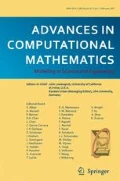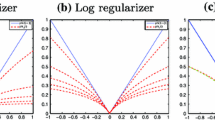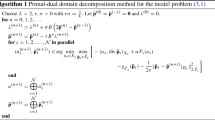Abstract
Recently, graph cuts algorithms have been used to solve variational image restoration problems, especially for noise removal and segmentation. Compared to time-marching PDE methods, graph cuts based methods are more efficient and able to obtain the global minimizer. However, for high resolution and large-scale images, the cost of both memory and computational time increases dramatically. In this paper, we combine the domain decomposition method and the graph cuts algorithm for solving the total variation minimizations with L 1 and L 2 fidelity term. Numerous numerical experiments on large-scale data demonstrate the proposed algorithm yield good results in terms of computational time and memory usage.
Similar content being viewed by others
References
Alliney, S.: Digital filters as absolute norm regularizers. IEEE Trans. Signal Process. 40(6), 1548–1562 (1992)
Alliney, S.: A property of the minimum vectors of a regularizing functional defined by means of the absolute norm. IEEE Trans. Signal Process. 45(4), 913–917 (1997)
Alliney, S., Ruzinsky, S.: An algorithm for the minimization of mixed l 1 and l 2 norms with application to Bayesian estimation. IEEE Trans. Signal Process. 42(3), 618–627 (1994)
Boykov, Y., Kolmogorov, V.: Computing geodesics and minimal surfaces via graph cuts. In: IEEE International Conference on Computer Vision, Nice, France, vol I, pp. 26–33 (2003)
Boykov, Y., Kolmogorov, V.: An experimental comparison of min-cut/max-flow algorithms for energy minimization in vision. IEEE Trans. Pattern Anal. Mach. Intell. 26(9), 1124–1137 (2004)
Boykov, Y., Veksler, O., Zabih, R.: Fast approximate energy minimization via graph cuts. IEEE Trans. Pattern Anal. Mach. Intell. 23(11), 1222–1239 (2001)
Chambolle, A.: An algorithm for total variation minimization and applications. J. Math. Imaging Vis. 20(1), 89–97 (2004)
Chambolle, A.: Total variation minimization and a class of binary MRF models. Energy minimization methods in computer vision and pattern recognition: 5th international workshop, EMMCVPR 2005. Lect. Notes Comput. Sci. 3757, 136–152 (2005)
Chan, T., Esedoglu, S.: Aspects of total variation regularized l 1 function approximation. SIAM J. Appl. Math. 65(5), 1817–1837 (2005)
Chan, T., Mathew, T.: Domain decomposition algorithms. Acta Numer. 3, 61–143 (1994)
Chan, T., Shen, J.: Image Processing and Analysis: Variational, PDE, Wavelet, and Stochastic Methods. Society for Industrial and Applied Mathematics (2005)
Chan, T., Shen, J., Vese, L.: Variational PDE models in image processing. Not. Am. Math. Soc. 50(1), 14–26 (2003)
Chen, K., Tai, X.: A nonlinear multigrid method for total variation minimization from image restoration. J. Sci. Comput. 33(2), 115–138 (2007)
Darbon, J.: Total variation minimization with l 1 data fidelity as a contrast invariant filter. In: Proceedings of the 4th International Symposium on Image and Signal Processing and Analysis (ISPA 2005), Zagreb, Croatia (2005)
Darbon, J., Sigelle, M.: Image restoration with discrete constrained total variation part I: fast and exact optimization. J. Math. Imaging Vis. 26(3), 261–276 (2006)
Darbon, J., Sigelle, M.: Image restoration with discrete constrained total variation part II: levelable functions, convex priors and non-convex cases. J. Math. Imaging Vis. 26(3), 277–291 (2006)
Dong, Y., Hintermúller, M., Neri, M.: A primal-dual method for L1 TV image denoising. SIAM J. Imaging Sci. 2, 577–613 (2009)
Ford, L., Fulkerson, D.: Flows in Networks. Princeton University Press (1962)
Gallo, G., Grigoriadis, M., Tarjan, R.: A fast parametric maximum flow algorithm and applications. SIAM J. Comput. 18(1), 30–55 (1989)
Goldberg, A., Tarjan, R.: A new approach to the maximum-flow problem. J. Assoc. Comput. Mach. (JACM) 35(4), 921–940 (1988)
Goldfarb, D., Yin, W.: Parametric maximum flow algorithms for fast total variation minimization. SIAM J. Sci. Comput. 31(5), 3712–3743 (2009)
Goldstein, T., Osher, S.: The split Bregman method for L1 regularized problems. SIAM J. Imaging Sci. 2(2), 323–343 (2009)
Greig, D., Porteous, B., Seheult, A.: Exact maximum a posteriori estimation for binary images. J. R. Stat. Soc., B (Methodological) 51(2), 271–279 (1989)
Guichard, F., Morel, J.: Mathematical morphology “almost everywhere”. In: Proceedings of ISMM, Csiro Publishing, pp. 293–303 (2002)
Ishikawa, H.: Exact optimization for Markov random fields with convex priors. IEEE Trans. Pattern Anal. Mach. Intell. 25(10), 1333–1336 (2003)
Jia, R., Zhao, H.: A fast algorithm for the total variation model of image denoising. Adv. Comput. Math. 33(2), 231–241 (2010)
Kolmogorov, V., Zabih, R.: What energy functions can be minimized via graph cuts? IEEE Trans. Pattern Anal. Mach. Intell. 26(2), 147–159 (2004)
Nikolova, M.: A variational approach to remove outliers and impulse noise. J. Math. Imaging Vis. 20(1), 99–120 (2004)
Osher, S., Sole, A., Vese, L.: Image decomposition and restoration using total variation minimization and the h − 1 norm. Multiscale Model. Simul. 1(3), 349–370 (2003)
Osher, S., Burger, M., Goldfarb, D., Xu, J., Yin, W.: An iterative regularization method for total variation-based image restoration. Multiscale Model. Simul. 4(2), 460–489 (2006)
Pollak, I., Willsky, A., Huang, Y.: Nonlinear evolution equations as fast and exact solvers of estimation problems. IEEE Trans. Signal Process. 53(2), 484–498 (2005)
Rudin, L., Osher, S., Fatemi, E.: Nonlinear total variation based noise removal algorithms. Physica D 60(1–4), 259–268 (1992)
Rudin, L., Osher, S., Inc, C., Santa Monica, C.: Total variation based image restoration with free local constraints. In: IEEE International Conference Image Processing, Austin, TX, pp. 31–35 (1994)
Sauer, K., Bouman, C.: Bayesian estimation of transmission tomograms using segmentation based optimization. IEEE Trans. Nucl. Sci. 39(4), 1144–1152 (1992)
Savage, J., Chen, K.: An improved and accelerated non-linear multigrid method for total-variation denoising. Int. J. Comput. Math. 82(8), 1001–1015 (2005)
Tai, X.: Parallel function decomposition and space decomposition methods: Part II. Space decomposition. Beijing Math. 1, 135–152 (1995)
Tai, X.: Rate of convergence for some constraint decomposition methods for nonlinear variational inequalities. Numer. Math. 93(4), 755–786 (2003)
Tai, X., Espedal, M.: Rate of convergence of some space decomposition methods for linear and nonlinear problems. SIAM J. Numer. Anal. 35(4), 1558–1570 (1998)
Tai, X., Wu, C.: Augmented lagrangian method, dual methods and split bregman iteration for ROF model. In: Scale Space and Variational Methods in Computer Vision, Second International Conference, pp. 502–513. Springer (2009)
Tai, X., Xu, J.: Global and uniform convergence of subspace correction methods for some convex optimization problems. Math. Comput. 71(237), 105–124 (2002)
Vogel, C., Oman, M.: Iterative methods for total variation denoising. SIAM J. Sci. Comput. 17(1), 227–238 (1996)
Wen, Y., Ng, M., Huang, Y.: Efficient total variation minimization methods for color image restoration. IEEE Trans. Image Process. 17(11), 2081–2088 (2008)
Wu, C., Tai, X.: Augmented Lagrangian method, dual methods, and split Bregman iteration for ROF, vectorial TV, and high order models. SIAM J. Imaging Sci. 3, 300–339 (2010)
Wu, C., Zhang, J., Tai, X.: Augmented Lagrangian method for total variation restoration with non-quadratic fidelity. UCLA CAM Report 09–82, Department of Mathematics, UCLA, Los Angeles, CA, CAM Report (2009)
Author information
Authors and Affiliations
Corresponding author
Additional information
Communicated by Yuesheng Xu and Hongqi Yang.
Rights and permissions
About this article
Cite this article
Duan, Y., Tai, XC. Domain decomposition methods with graph cuts algorithms for total variation minimization. Adv Comput Math 36, 175–199 (2012). https://doi.org/10.1007/s10444-011-9213-4
Received:
Accepted:
Published:
Issue Date:
DOI: https://doi.org/10.1007/s10444-011-9213-4
Keywords
- Total variation minimization
- TV − L 1 model
- ROF model
- Graph cuts
- Domain decomposition
- Successive subspace correction




